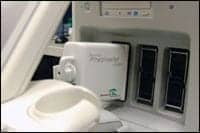Every physician and sonographer understands the importance of image quality when performing ultrasound exams. Without a high-quality image, identifying abnormalities is not only difficult, but also less reliable. This makes image quality critically important for proper diagnosis and to guide patient care.
One of the most exciting recent advances in ultrasound transducer technology is the added capability of live 3D imaging during transesophageal echocardiogram (TEE) studies. These new TEE transducers use complex matrix arrays instead of standard phased arrays, allowing the physician to obtain a more accurate visualization of the anatomy than with the lengthy traditional approach of rendering multiple 2D acquisitions offline. Because 3D TEE visualizes entire anatomic structures at a glance, the technology has been increasingly adopted to plan mitral valve surgery and to guide catheter-based mitral valve repair.
Technology Challenges
As with any technology, however, the TEE transducer’s advanced multidimensional capabilities do not mean it is foolproof when it comes to performance. TEE transducers are very fragile, complex, and prone to many issues, from poor image quality and missing information to noise and data-transmission problems. Compared with 2D, the rate of artifacts is amplified, not reduced, with 3D and 4D systems. Why? Because the sophisticated software compensation and software-resolution scaling that occur on multidimensional TEE equipment can hide artifacts by making them more subtle.
These factors make it particularly important to understand how to use the new TEE ultrasound probes and identify anything amiss. Unfortunately, as sonographers are probably aware, no standard or objective method exists for measuring image quality. Therefore, extensive practice and a trained eye are what sonographers typically rely on to identify artifacts and determine the quality of an image.
However, as with standard ultrasound transducers, there are certain signs sonographers can look for when using the new TEE transducers to spot anything out of the ordinary. Any image noise and color artifact, such as unintended variation in the brightness, color, saturation, or contrast of an image, is cause for suspicion. Some signs, such as image distortion (rearranged material) or color stripes or noise in a nonphysiologic pattern, clearly indicate an equipment problem. Are all of the scan lines parallel? Or are some out of line or fuzzy in comparison to adjacent scan lines?
In extreme cases, an image may appear too bright or white, or too dark—a sure sign of malfunction. The most difficult problem is when a change is subtle; the sonographer must then decide whether the artifact is clinically feasible or not—in other words, whether it is due to patient pathology or data error. Dropout in the image (missing signal) is a good example: Ultrasound is famous for having dropouts, but judgment and experience are required to determine whether the dropout observed indicates a malfunction.
With a transthoracic echo probe, the sonographer could spend time checking previous reports on the patient to see whether any diagnostic image-quality problems had been reported on earlier exams. Or, the sonographer could struggle to image another patient—or two or three—to prove that “it’s not just that patient” and confirm the suspicion of a probe problem. For a TEE ultrasound probe, however, such steps are inadvisable—it is of paramount importance to ensure that the ultrasound equipment will not prevent a procedure from going smoothly. In fact, sonographers should not have to wonder whether it is the patient or the probe causing an issue. Rather, they should be enabled to focus on learning to identify artifacts. Then they and their administrators should explore other, preventative measures to ensure image quality and accurate diagnoses.
Maintenance
First and foremost when it comes to prevention is the proper maintenance and care of the TEE system. When first receiving new equipment, the sonographer or biomedical engineer should conduct a live-system test to ensure it is in working order. The American College of Radiology (ACR) Technical Standard specifies that acceptance testing must be performed when new equipment is acquired as well as after equipment repairs and major upgrades. For example, the ACR standard notes that tests on transducers should include physical and mechanical inspection, image uniformity and artifact survey, geometric accuracy, system sensitivity, spatial resolution, and contrast resolution.1
Once the system is accepted, careful handling and sterilization of probes helps control equipment service costs. The American Institute of Ultrasound in Medicine (AIUM) has posted guidance regarding the cleaning and preparation of external and internal ultrasound probes on its website.2 It is critical to establish a regular surveillance schedule to guarantee that the transducer is functioning properly over time and with regular use. The AIUM has published recommended or mandatory equipment surveys to be performed, some daily and others at least once a year.3
The Intersocietal Accreditation Commission requires that manufacturer’s guidelines be followed “for the appropriate care and cleansing of the TEE transducer and adhere to the appropriate infectious disease standards to prevent the transmission of disease.” In addition, beginning December 31, 2015, “the structural and electrical integrity of the transducer must be checked between each use, using an ultrasound transducer leakage tester. ‘Passed’ or ‘Failed’ must be documented in the routine TEE probe cleaning/maintenance log along with action taken if ‘failed.’ ”4
Testing and Repair
Various tools are marketed to test whether a probe is in good shape. Scanners (calibration tools) can be used to identify imaging issues, while certain probe-testing devices can be used to measure and detect any issues related to the acoustic and electrical properties of an ultrasound probe. But while these devices may help in certain instances, the best approach to ultrasound equipment testing is live-system testing. Only live-system testing is capable of capturing real images to assess their quality; only live-system testing can reveal the intermittent problems that comprise the majority of issues associated with a probe. Simply stated, there is no substitute for an image-quality test on a live ultrasound system.
Once a problem is identified, biomedical engineers and hospital administrators should first consider a repair. The cost of repairing faulty equipment is much lower than the cost of replacement. Opting to repair rather than replace the technology can maximize its useful life and save healthcare facilities as much as 97% relative to the cost of original equipment manufacturer replacements. However, it is important to note that the repairability of a compromised TEE transducer decreases rapidly as time passes, due to the corrosion of its materials. For this reason, any technical problems should be acted upon as soon as they are detected to ensure a successful repair.
Prompt repair is particularly important for real-time, multidimensional TEE transducers because delay may make them significantly more difficult to service. Due to their higher power and smaller form factor, damage from electrical shorts is more catastrophic. Hospital administrators should therefore seek to partner with a reputable, well-trained team of ultrasound support technicians who can repair equipment down to the component level. Factors to consider when choosing an ultrasound support provider include whether the provider does all the work in-house, has the technical expertise to provide in-depth failure analysis, and turns work around quickly.
Probe Integrity Is Critical
When it comes to accurately assessing and diagnosing cardiac patients, TEE probe integrity should be taken very seriously. This is particularly true when 3D TEE is being used for procedural guidance. As reliance on TEE technology continues to grow and take over functions once dominated by other imaging modalities, ensuring high-quality images will become increasingly important to top-notch patient care. Learning how to spot image anomalies and properly test and care for equipment—and acting at the first sign of any deterioration or failure—will make all the difference.
Lawrence Nguyen is founder and CEO of Summit Imaging, Woodinville, Wash. For more information, contact 24×7 editorial director John Bethune at [email protected].
References
1. ACR. Technical Standard for Diagnostic Medical Physics Performance Monitoring of Real Time Ultrasound Equipment. 2011. Available at: http://www.acr.org/~/media/152588501B3648BA803B38C8172936F9.pdf. Accessed August 5, 2014.
2. AIUM. Guidelines for Cleaning and Preparing External- and Internal-Use Ultrasound Probes Between Patients. 2014. Available at: http://www.aium.org/officialStatements/57. Accessed August 5, 2014.
3. AIUM. Routine Quality Assurance for Diagnostic Ultrasound Equipment. 2008. Available at: http://www.aium.org/store/products.aspx?cId=102&page=2. Accessed August 5, 2014.
4. IAC. Standards for Adult Echocardiography Accreditation. 2014. Available at: http://www.intersocietal.org/echo/main/echo_standards.htm. Accessed August 5, 2014.




